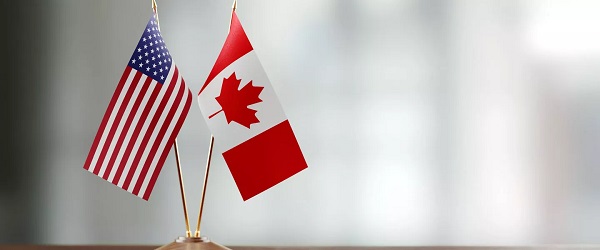Business
Trump, taunts and trade—Canada’s response is a decade out of date

From the Fraser Institute
Canadian federal politicians are floundering in their responses to Donald Trump’s tariff and annexation threats. Unfortunately, they’re stuck in a 2016 mindset, still thinking Trump is a temporary aberration who should be disdained and ignored by the global community. But a lot has changed. Anyone wanting to understand Trump’s current priorities should spend less time looking at trade statistics and more time understanding the details of the lawfare campaigns against him. Canadian officials who had to look up who Kash Patel is, or who don’t know why Nathan Wade’s girlfriend finds herself in legal jeopardy, will find the next four years bewildering.
Three years ago, Trump was on the ropes. His first term had been derailed by phony accusations of Russian collusion and a Ukrainian quid pro quo. After 2020, the Biden Justice Department and numerous Democrat prosecutors devised implausible legal theories to launch multiple criminal cases against him and people who worked in his administration. In summer 2022, the FBI raided Mar-a-Lago and leaked to the press rumours of stolen nuclear codes and theft of government secrets. After Trump announced his candidacy in 2022, he was hit by wave after wave of indictments and civil suits strategically filed in deep blue districts. His legal bills soared while his lawyers past and present battled well-funded disbarment campaigns aimed at making it impossible for him to obtain counsel. He was assessed hundreds of millions of dollars in civil penalties and faced life in prison if convicted.
This would have broken many men. But when he was mug-shotted in Georgia on Aug. 24, 2023, his scowl signalled he was not giving in. In the 11 months from that day to his fist pump in Butler, Pennsylvania, Trump managed to defeat and discredit the lawfare attacks, assemble and lead a highly effective campaign team, knock Joe Biden off the Democratic ticket, run a series of near daily (and sometimes twice daily) rallies, win over top business leaders in Silicon Valley, open up a commanding lead in the polls and not only survive an assassination attempt but turn it into an image of triumph. On election day, he won the popular vote and carried the White House and both Houses of Congress.
It’s Trump’s world now, and Canadians should understand two things about it. First, he feels no loyalty to domestic and multilateral institutions that have governed the world for the past half century. Most of them opposed him last time and many were actively weaponized against him. In his mind, and in the thinking of his supporters, he didn’t just defeat the Democrats, he defeated the Republican establishment, most of Washington including the intelligence agencies, the entire corporate media, the courts, woke corporations, the United Nations and its derivatives, universities and academic authorities, and any foreign governments in league with the World Economic Forum. And it isn’t paranoia; they all had some role in trying to bring him down. Gaining credibility with the new Trump team will require showing how you have also fought against at least some of these groups.
Second, Trump has earned the right to govern in his own style, including saying whatever he wants. He’s a negotiator who likes trash-talking, so get used to it and learn to decode his messages.
When Trump first threatened tariffs, he linked it to two demands: stop the fentanyl going into the United States from Canada and meet our NATO spending targets. We should have done both long ago. In response, Trudeau should have launched an immediate national action plan on military readiness, border security and crackdowns on fentanyl labs. His failure to do so invited escalation. Which, luckily, only consisted of taunts about annexation. Rather than getting whiny and defensive, the best response (in addition to dealing with the border and defence issues) would have been to troll back by saying that Canada would fight any attempt to bring our people under the jurisdiction of the corrupt U.S. Department of Justice, and we will never form a union with a country that refuses to require every state to mandate photo I.D. to vote and has so many election problems as a result.
As to Trump’s complaints about the U.S. trade deficit with Canada, this is a made-in-Washington problem. The U.S. currently imports $4 trillion in goods and services from the rest of the world but only sells $3 trillion back in exports. Trump looks at that and says we’re ripping them off. But that trillion-dollar difference shows up in the U.S. National Income and Product Accounts as the capital account balance. The rest of the world buys that much in U.S. financial instruments each year, including treasury bills that keep Washington functioning. The U.S. savings rate is not high enough to cover the federal government deficit and all the other domestic borrowing needs. So the Americans look to other countries to cover the difference. Canada’s persistent trade surplus with the U.S. ($108 billion in 2023) partly funds that need. Money that goes to buying financial instruments can’t be spent on goods and services.
So the other response to the annexation taunts should be to remind Trump that all the tariffs in the world won’t shrink the trade deficit as long as Congress needs to borrow so much money each year. Eliminate the budget deficit and the trade deficit will disappear, too. And then there will be less money in D.C. to fund lawfare and corruption. Win-win.
Automotive
Politicians should be honest about environmental pros and cons of electric vehicles

From the Fraser Institute
By Annika Segelhorst and Elmira Aliakbari
According to Steven Guilbeault, former environment minister under Justin Trudeau and former member of Prime Minister Carney’s cabinet, “Switching to an electric vehicle is one of the most impactful things Canadians can do to help fight climate change.”
And the Carney government has only paused Trudeau’s electric vehicle (EV) sales mandate to conduct a “review” of the policy, despite industry pressure to scrap the policy altogether.
So clearly, according to policymakers in Ottawa, EVs are essentially “zero emission” and thus good for environment.
But is that true?
Clearly, EVs have some environmental advantages over traditional gasoline-powered vehicles. Unlike cars with engines that directly burn fossil fuels, EVs do not produce tailpipe emissions of pollutants such as nitrogen dioxide and carbon monoxide, and do not release greenhouse gases (GHGs) such as carbon dioxide. These benefits are real. But when you consider the entire lifecycle of an EV, the picture becomes much more complicated.
Unlike traditional gasoline-powered vehicles, battery-powered EVs and plug-in hybrids generate most of their GHG emissions before the vehicles roll off the assembly line. Compared with conventional gas-powered cars, EVs typically require more fossil fuel energy to manufacture, largely because to produce EVs batteries, producers require a variety of mined materials including cobalt, graphite, lithium, manganese and nickel, which all take lots of energy to extract and process. Once these raw materials are mined, processed and transported across often vast distances to manufacturing sites, they must be assembled into battery packs. Consequently, the manufacturing process of an EV—from the initial mining of materials to final assembly—produces twice the quantity of GHGs (on average) as the manufacturing process for a comparable gas-powered car.
Once an EV is on the road, its carbon footprint depends on how the electricity used to charge its battery is generated. According to a report from the Canada Energy Regulator (the federal agency responsible for overseeing oil, gas and electric utilities), in British Columbia, Manitoba, Quebec and Ontario, electricity is largely produced from low- or even zero-carbon sources such as hydro, so EVs in these provinces have a low level of “indirect” emissions.
However, in other provinces—particularly Alberta, Saskatchewan and Nova Scotia—electricity generation is more heavily reliant on fossil fuels such as coal and natural gas, so EVs produce much higher indirect emissions. And according to research from the University of Toronto, in coal-dependent U.S. states such as West Virginia, an EV can emit about 6 per cent more GHG emissions over its entire lifetime—from initial mining, manufacturing and charging to eventual disposal—than a gas-powered vehicle of the same size. This means that in regions with especially coal-dependent energy grids, EVs could impose more climate costs than benefits. Put simply, for an EV to help meaningfully reduce emissions while on the road, its electricity must come from low-carbon electricity sources—something that does not happen in certain areas of Canada and the United States.
Finally, even after an EV is off the road, it continues to produce emissions, mainly because of the battery. EV batteries contain components that are energy-intensive to extract but also notoriously challenging to recycle. While EV battery recycling technologies are still emerging, approximately 5 per cent of lithium-ion batteries, which are commonly used in EVs, are actually recycled worldwide. This means that most new EVs feature batteries with no recycled components—further weakening the environmental benefit of EVs.
So what’s the final analysis? The technology continues to evolve and therefore the calculations will continue to change. But right now, while electric vehicles clearly help reduce tailpipe emissions, they’re not necessarily “zero emission” vehicles. And after you consider the full lifecycle—manufacturing, charging, scrapping—a more accurate picture of their environmental impact comes into view.
Business
Fuelled by federalism—America’s economically freest states come out on top

From the Fraser Institute
Do economic rivalries between Texas and California or New York and Florida feel like yet another sign that America has become hopelessly divided? There’s a bright side to their disagreements, and a new ranking of economic freedom across the states helps explain why.
As a popular bumper sticker among economists proclaims: “I heart federalism (for the natural experiments).” In a federal system, states have wide latitude to set priorities and to choose their own strategies to achieve them. It’s messy, but informative.
New York and California, along with other states like New Mexico, have long pursued a government-centric approach to economic policy. They tax a lot. They spend a lot. Their governments employ a large fraction of the workforce and set a high minimum wage.
They aren’t socialist by any means; most property is still in private hands. Consumers, workers and businesses still make most of their own decisions. But these states control more resources than other states do through taxes and regulation, so their governments play a larger role in economic life.
At the other end of the spectrum, New Hampshire, Tennessee, Florida and South Dakota allow citizens to make more of their own economic choices, keep more of their own money, and set more of their own terms of trade and work.
They aren’t free-market utopias; they impose plenty of regulatory burdens. But they are economically freer than other states.
These two groups have, in other words, been experimenting with different approaches to economic policy. Does one approach lead to higher incomes or faster growth? Greater economic equality or more upward mobility? What about other aspects of a good society like tolerance, generosity, or life satisfaction?
For two decades now, we’ve had a handy tool to assess these questions: The Fraser Institute’s annual “Economic Freedom of North America” index uses 10 variables in three broad areas—government spending, taxation, and labor regulation—to assess the degree of economic freedom in each of the 50 states and the territory of Puerto Rico, as well as in Canadian provinces and Mexican states.
It’s an objective measurement that allows economists to take stock of federalism’s natural experiments. Independent scholars have done just that, having now conducted over 250 studies using the index. With careful statistical analyses that control for the important differences among states—possibly confounding factors such as geography, climate, and historical development—the vast majority of these studies associate greater economic freedom with greater prosperity.
In fact, freedom’s payoffs are astounding.
States with high and increasing levels of economic freedom tend to see higher incomes, more entrepreneurial activity and more net in-migration. Their people tend to experience greater income mobility, and more income growth at both the top and bottom of the income distribution. They have less poverty, less homelessness and lower levels of food insecurity. People there even seem to be more philanthropic, more tolerant and more satisfied with their lives.
New Hampshire, Tennessee, and South Dakota topped the latest edition of the report while Puerto Rico, New Mexico, and New York rounded out the bottom. New Mexico displaced New York as the least economically free state in the union for the first time in 20 years, but it had always been near the bottom.
The bigger stories are the major movers. The last 10 years’ worth of available data show South Carolina, Ohio, Wisconsin, Idaho, Iowa and Utah moving up at least 10 places. Arizona, Virginia, Nebraska, and Maryland have all slid down 10 spots.
Over that same decade, those states that were among the freest 25 per cent on average saw their populations grow nearly 18 times faster than those in the bottom 25 per cent. Statewide personal income grew nine times as fast.
Economic freedom isn’t a panacea. Nor is it the only thing that matters. Geography, culture, and even luck can influence a state’s prosperity. But while policymakers can’t move mountains or rewrite cultures, they can look at the data, heed the lessons of our federalist experiment, and permit their citizens more economic freedom.
-

 Focal Points2 days ago
Focal Points2 days agoCommon Vaccines Linked to 38-50% Increased Risk of Dementia and Alzheimer’s
-

 Automotive1 day ago
Automotive1 day agoThe $50 Billion Question: EVs Never Delivered What Ottawa Promised
-

 Business2 days ago
Business2 days agoCanada invests $34 million in Chinese drones now considered to be ‘high security risks’
-

 Alberta16 hours ago
Alberta16 hours agoAlberta introducing three “all-season resort areas” to provide more summer activities in Alberta’s mountain parks
-

 Health2 days ago
Health2 days agoThe Data That Doesn’t Exist
-

 Business1 day ago
Business1 day agoStorm clouds of uncertainty as BC courts deal another blow to industry and investment
-

 Agriculture15 hours ago
Agriculture15 hours agoGrowing Alberta’s fresh food future
-

 Business2 days ago
Business2 days agoThe Climate-Risk Industrial Complex and the Manufactured Insurance Crisis








